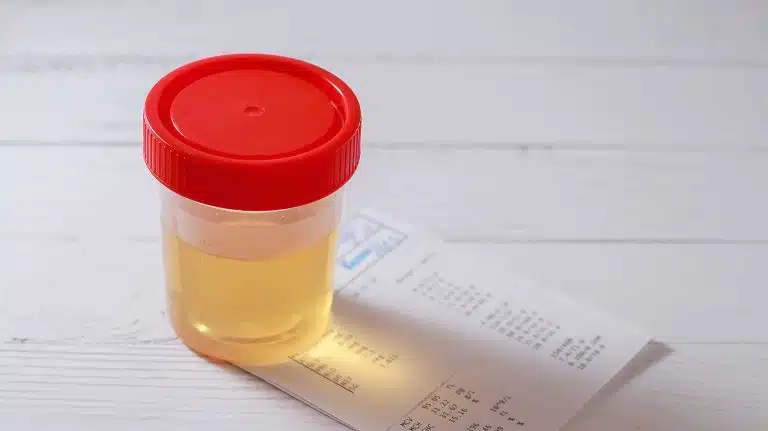How Long Does Tramadol Stay In Your System?
- Tramadol Drug Tests & Detection Windows
- Urine Test
- Hair Test
- Saliva Test
- Blood Test
- Half-Life Of Tramadol
- Immediate-Release Tramadol
- Extended-Release Tramadol

Tramadol can stay in your system for about 32 to 42 hours after the last dose. The timeframe for how long tramadol stays in a person’s system can be affected by many factors outside the drug itself.
A person’s body composition, history of substance abuse, drug tolerance, and health conditions can change the elimination time of tramadol.
Drug screens can detect traces of tramadol for up to 90 days after the last use. A test can be done if you show signs of tramadol abuse, such as withdrawal symptoms. Consistent side effects of tramadol, like constipation, drowsiness, and vomiting, may also be reasons for testing.
Tramadol Drug Tests & Detection Windows
Tramadol drug tests look for either the unchanged drug in your system or tramadol’s metabolites. Metabolites are unique versions of a drug after it has been broken down by enzymes in the body. Tramadol’s main metabolite is O-desmethyltramadol, or M1.
Tramadol and its metabolites can still be found in some parts of the body after it has been mostly eliminated.
Drug tests may be done by your employer or healthcare provider. In both cases, they may be checking for signs of chronic drug use.
Urine Test
Tramadol can be detected in a urine test for up to 3 days after the last dose. In people who struggle with long-term tramadol abuse, the detection window in urine and maybe longer.
Urine tests are a common form of drug screens. A test may check for metabolites of many different substances, including opiates, prescription opioids, cocaine, marijuana, and others.
Hair Test
Tramadol stays in hair follicles for up to 90 days after the last dose. The detection window for hair tests is one of the longest out of the forms of drug testing.
Drugs can enter the hair through the bloodstream, and stay there as the hair grows. The hair testing process can be relatively quick and convenient while looking for multiple substances.
Saliva Test
Tramadol can be found in saliva for up to 48 hours after the last dose. A saliva drug test may involve a cheek swab or saliva that is directly taken from the mouth.
Saliva tests are often more sensitive than other forms of testing. They may pick up smaller traces of drugs, but can also have higher chances of returning false positive tests.
Blood Test
Tramadol may only be found in the blood for hours after it is taken. During this time, it may still be active in the body.
Blood testing is usually an expensive form of drug screening. While it can be effective, other forms of testing may be more convenient, while still being accurate.
Half-Life Of Tramadol
The half-life of tramadol is usually about 6 hours. Half-life is the amount of time it takes for a substance to reach half of its maximum concentration. Usually, the half-life of a substance is independent of factors like release time but may be affected by dosing.
Half-life can be used to determine how long the substance stays in your bloodstream. After about 5 half-life cycles, almost all of a drug has left your system. 5 half-life cycles of tramadol is about 30 hours.
Half-life is consistent across most types of tramadol. Preexisting health conditions can affect half-life, however. Patients with renal (kidney) problems and older patients (over 65 years) may experience longer half-lives when taking tramadol, partly due to their lower metabolic rates.
Immediate-Release Tramadol
Ultram, a common tramadol prescription, may be given as either an immediate-release or extended-release pain medication. Immediate-release tramadol tends to come in higher doses.
Immediate-release tramadol takes about 2 hours to reach maximum concentration in the body. It starts being broken down by the body sooner than slow-acting tramadol, leading to a shorter average elimination time of about 32 hours.
Extended-Release Tramadol
Most brand-name tramadol prescription drugs are extended-release, including Ultram ER, Conzip, and QDolo. Extended-release and immediate-release tramadol share the same half-life of about 6 hours.
Extended-release tramadol takes about 10 to 12 hours to reach maximum concentration in the body. After this amount of time, it starts being broken down by the body and is almost completely eliminated after about 40 hours.
Long-acting tramadol’s analgesic (pain relief) effects take longer to set in but also last longer. This slow-acting formula is the main reason why it takes longer to leave the body than fast-acting tramadol.
Treating Tramadol Abuse
Drug tests are often done under suspicion of drug abuse. Tramadol is a controlled substance with known abuse potential. Testing positive for tramadol use may mean that an opioid treatment program can help you recover.
To find the best treatment options for tramadol abuse and addiction, talk to your healthcare professional or contact us today.
Written by Ark Behavioral Health Editorial Team
©2024 Ark National Holdings, LLC. | All Rights Reserved.
This page does not provide medical advice.
Hindawi - Tramadol Extended-Release for the Management of Pain due to Osteoarthritis
Labcorp - Hair Drug Testing
National Centers for Biotechnology Information - OBJECTIVE TESTING – URINE AND OTHER DRUG TESTS
National Centers for Biotechnology Information - PharmGKB summary: tramadol pathway
Palliative Care Network of Wisconsin - Urine Drug Testing for Opioids and Marijuana
U.S. Food and Drug Administration - tramadol hydrochloride
U.S. Food and Drug Administration - Ultram (tramadol hydrochloride)
U.S. National Library of Medicine - Opioid Testing: MedlinePlus
U.S. National Library of Medicine - Tramadol hydrochloride | C16H26ClNO2

Questions About Treatment?
Ark Behavioral Health offers 100% confidential substance abuse assessment and treatment placement tailored to your individual needs. Achieve long-term recovery.
100% confidential. We respect your privacy.
Prefer Texting?
Our friendly support team is here to chat 24/7. Opt out any time.







 Learn More
Learn More








